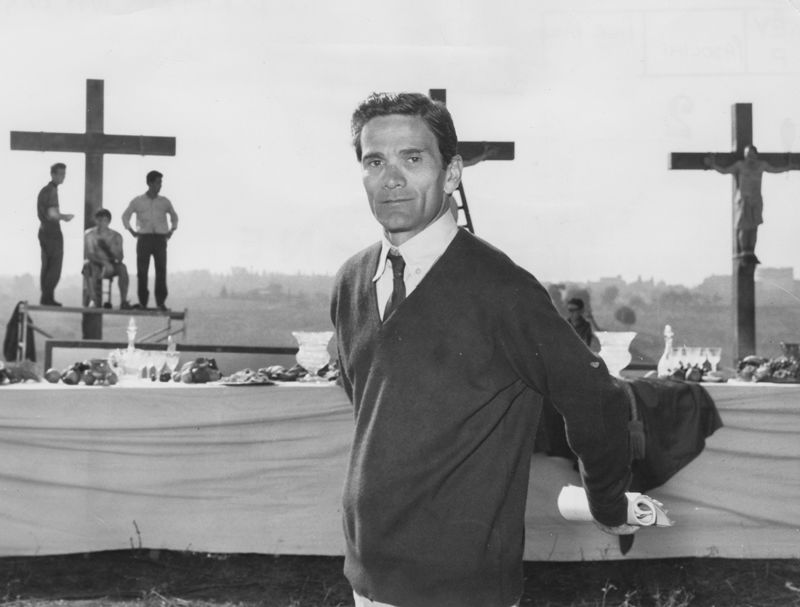Pier Paolo Pasolini (1922-1975), was an Italian filmmaker, writer and poet.
Part intellectual, part peasant; part Marxist, part broken-hearted Catholic, as a youth, he sold his novels and poetry on the streets of Rome. He knew that power always tends to the right. He was gay without making a campaign out of it.
He was once arrested for lewd public acts, he was a constant target for the tabloid press, and his work became increasingly darker and controversial as he aged (“Salò,” his last film, is considered by many to be unwatchable).
He was murdered in 1975, brutally beaten and run over multiple times by his own Alfa Romeo in a late-night pick-up gone wrong.
And he made at least one movie for which alone he should be awarded the crown of stars: “The Gospel According to St. Matthew” (1964).
Barth David Schwartz tells the story of the making of the film in “Pasolini Requiem.”
Pope John XXIII — to whom the film is dedicated — had called for a new dialogue with non-Catholic artists. In 1962, Pasolini found himself stuck for a weekend conference in Assisi. He picked up a copy of the Gospels, and “read them straight through.”
Instantly, all his other planned projects fell away. “The idea of making a film … alone remained, alive and thriving within me.”
He used no script. Every word in the film comes directly from Matthew’s Gospel.
He used “real people” in his film, including his own mother (with whom he continued to live as an adult) as the older Virgin Mary. People with real emotions, ravaged faces, bad teeth.
“I have an almost ideological esthetic preference for nonprofessional actors,” Pasolini observed, “who themselves are shreds of reality as is a landscape, a sky, the sun, a donkey passing along the road.”
Enrique Irazoqui, the 19-year-old Spanish economics student who played Christ, had never acted before, and, after “The Gospel According to St. Matthew,” never acted again. Slender, good-looking but not movie-star handsome, Irazoqui had a head of oiled dark hair, swept straight back, and eyebrows that meet.
Watching him, you feel, “This is exactly what Christ would look like and act like.” Intense, but not fanatical. Fierce yet tender. On fire but contained. Possessed of absolute integrity, but without the desire to retaliate, lord it over, or be vindicated. One of us and yet … of an entirely different realm and utterly unique.
The film was shot in black-and-white, mostly in the poor Italian district of Basilicata. The rocky mountainsides, people wandering in hooded robes and noisy, dusty marketplaces resemble the pictures from my 1950s-era childhood Bible. Clearly the budget didn’t allow for special effects, but the integrity of the filmmaking forbids laughter.
The opening scene, where Joseph discovers Mary is pregnant, the baptism, the miracle of the loaves and the fishes, the night where, praying in the Garden at Gethsemane, Christ sees the torches of the Roman soldiers approaching through the gloom and knows his hour is come, are affecting in a way no other “religious” film in my experience remotely approaches.
As Christ comes into Jerusalem, knowing he’ll soon be crucified, a raucous band of little children tug at his sleeves, crowd in to be hugged and exuberantly rattle their palm fronds. The camera ranges over their grimy faces, then back to Christ, who is gazing upon them with unalloyed delight. It’s the one time in the film he full-on smiles.
The score includes Bach’s Mass in B Minor, Odetta’s “Sometimes I Feel Like a Motherless Child,” and the Missa Luba, a version of the Latin Mass based on traditional Congolese songs.
Last year the Vatican newspaper L’Osservatore Romano described “The Gospel According to St. Matthew” as “the best film about Jesus ever made in the history of cinema.”
But it was in reading a letter to his student and friend Tonuti Spagnol, dated Oct. 25, 1946, that I felt a true kinship with Pasolini.
“Something quite powerful happened to me yesterday. While I was standing on one of the Tiber bridges, waiting for friends (it was night), there came to me the idea of descending the staircase which carried one down to water level. … It was very dark; I could make out the arches of the bridge over my head and, along the river’s length, could make out lamps, in infinite number of lamps. I was about 20 meters below the level of the city and its din came muffled to me, as from another world. I really never thought that in the heart of a metropolis it was enough to descend a staircase to enter the most absolute solitude.”
In Rome last October, I, too, walked alone along the banks of the Tiber. I, too, descended below the city into a profound solitude. I, too, was entranced as night came on, at the “infinite number” of lamps, shining in the darkness.
It’s the same hushed solitude, with the mountains in the distance and the blank sky above, in which the closing scene of “The Gospel According to St. Matthew” seems to have been shot.
It’s the moment when the stone slab covering the entrance to Christ’s tomb falls aside — and we see the tomb is empty.

